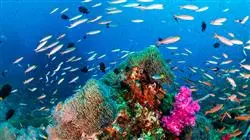University certificate
The world's largest faculty of veterinary medicine”
Description
Do not miss the opportunity to study this postgraduate diploma in Wildlife Mapping and Potential Distribution Models with us. It's the perfect opportunity to stand out and advance your career”

Unlike other programs, the postgraduate diploma in Wildlife Mapping and Potential Distribution Models approaches wildlife management from an interdisciplinary point of view.
Wildlife management covers a wide spectrum of lines of research and action, in addition to the study of health surveillance and disease control, which is usually the general line of study in similar programs. However, in the future, veterinary professionals will have to face other lines of work in biodiversity conservation, which are also extensively developed throughout the syllabus.
Nowadays, it is difficult to find a program like this one, which provides students with specialized education in the use of the most common software in daily practice. Today there are many computer tools available that are considered necessary and that facilitate and increase the level of quality of work, which are considered necessary.
Species biology is not only based on theoretical knowledge, but also on spatial and geolocalized data. The only way to understand and visualize how species are distributed is by using Geographic Information Systems to represent and model the data.
This complete training program is designed by professors with the highest recognized degree of specialization, thus guaranteeing its quality in all aspects in wildlife, both clinical and scientific. A unique opportunity to specialize in an area where professional positions are in high demand, from the hands of outstanding professionals.
Train at TECH and learn the concepts associated with wildlife populations and the processes and interactions that take place”
This postgraduate diploma in Wildlife Mapping and Potential Distribution Models contains the most complete and up-to-date scientific program on the market. The most important features include:
- Case studies presented by experts in Wildlife
- The graphic, schematic, and practical contents with which they are created, provide scientific and practical information on the disciplines that are essential for professional development
- New developments in Wildlife Management
- Practical exercises where the self-assessment process can be carried out to improve learning
- Special emphasis on innovative methodologies in Wildlife Management
- Theoretical lessons, questions to the expert, debate forums on controversial topics, and individual reflection work
- Content that is accessible from any fixed or portable device with an Internet connection
This postgraduate diploma is the best investment you can make when selecting a refresher program in Wildlife Mapping and Potential Distribution Models “
It includes, in its Teaching staff, Professionals belonging to the veterinary field, who pour into this training the experience of their work, in addition to recognized Specialists from Reference Societies and Prestigious Universities.
The multimedia content, developed with the latest educational technology, will provide the professional with situated and contextual learning, i.e., a simulated environment that will provide immersive specialization programmed to learn in real situations.
This program is designed around Problem-Based Learning, whereby the specialist must try to solve the different professional practice situations that arise throughout the program. For this, the professional will have the help of an innovative, interactive video system made by recognized and experienced experts in Wildlife.
This program comes with the best educational material, providing you with a contextual approach that will facilitate your learning"

This 100% online postgraduate diploma will allow you to combine your studies with your professional work while expanding your knowledge in this field"
Objectives
The postgraduate diploma in Wildlife Mapping and Potential Distribution Models is designed to facilitate the performance of veterinary professionals with the latest advances and most innovative procedures in the sector.

You will learn to analyze one of the main threats to biodiversity loss, i.e., invasive alien species, establishing the main lines of action to manage them”
General Objectives
- Determine the official resources that yield species distribution information
- Examine the resources available to characterize potential habitats where species are distributed
- Introduce the different portals that provide species conservation data and identify or interpret each type of data
- Learn more about the formats and types of data and files offered by these portals
Understand the potential of geographic information systems (GIS) in the management of species distribution data, their environments and monitoring strategies - Manage QGIS software to manage field sampling data
- Analyze the available territorial data to obtain strategic maps that fulfill specific functions in species management
- Represent the available information and the processed results within GIS
- Know the cartographic requirements to manage Maxent
- Manage using Maxent working software
- Identify the program's input and output file formats
- Interpret modeling results
Specific Objectives
Module 1. Resources to Acquire and Analyze Data on Species Distribution, Natural Areas and Environmental Habitat Variables
- Access official conservation data on species included in the European Natura 2000 Network through their official databases or Natura 2000 Standard Data Forms
- Consult conservation data and species distribution mapping through public and private organizations and institutions portals
- Warn of the potential offered by citizen science as a resource or documentary source for acquiring and sharing species distribution data and monitoring over time
- Learn about and explore portals to download information on species distribution linked to citizen science
- Identify land uses and networks of protected natural areas worldwide that may support or harbor species
- Consult and acquire, from official websites, descriptive digital models of the physical and biological environment of species, such as climatic data, physical data or territorial
- morphology, for further geographical analysis of potential distributions
Module 2. Spatial Management of Species using Geographic Information Systems in QGIS
- Understand the key functionalities offered by geographic information systems
- Manage basic symbology and geoprocessing analysis tools in QGIS
- Establish cartographic methodologies to manage territorial plots for species monitoring and analysis
- Dump and represent field data linked to species using GIS
- Manage QGIS plugins to virtually collect species distribution data
- Create thematic maps to represent particular aspects of censuses or inventories, such as richness maps or effort maps
- Analyze territorial variables in order to obtain species suitability maps that can be used for conservation purposes
- Develop ecological corridors between natural areas in order to plan conservation routes for species migration
- Understand the key concepts linked to field data collection in order to obtain correctly documented and technically feasible mapping
Module 3. Potential Species Distribution Modeling with Maxent
- Recognize the specific input file formats supported by the program so the model works correctly
- Correctly produce quality mapping of territorial variables to run a model
- Correctly cite the coordinate structure of species distribution to run a model
- Understand the different types of models generated by Maxent
- Model the potential distribution of species, both in present and future time
- Interpret the data, graphs, and visual maps provided by Maxent as a result of spatial data analysis
- Represent and interpret the resulting data through a GIS such as QGIS

A unique specializacion program that will allow you to acquire advanced training in this field"
Postgraduate Diploma in Faunal Cartography and Potential Distribution Models
The use of scientific knowledge for wildlife management is of utmost importance for a wide range of disciplinary lines of research and action. With the right performance and results, it is beneficial not only for addressing environmental issues, but also for the development of different processes useful to society. In an environment as competitive as that of veterinary medicine, it is important that professionals are increasingly trained in different areas of interest to their professional field. For this reason, at TECH Global University we have designed a Postgraduate Diploma program that will allow you to deepen your knowledge of Faunistic Cartography and Potential Distribution Models.
Become an expert in the management of wildlife
If your objectives include updating and systematizing information related to the habitat of different animal species, this program is for you. In this Postgraduate Diploma you will have the opportunity to study wildlife management from an interdisciplinary perspective. This means that, in addition to addressing issues such as health surveillance or disease control, you will have access to other issues of interest to the field of veterinary medicine, such as biodiversity conservation. Thus, after completing this Postgraduate Certificate you will not only be able to determine and examine available resources through the use of modeling tools, but you will also be able to contribute to the representation and characterization of habitats and potential distribution ecosystems for species.
Get your degree at the university with the largest Veterinary Faculty.
At TECH Global University we have the largest Veterinary Faculty. Our specialized programs offer you the most updated and complete academic content in the market, in addition to unique methodologies for online teaching. With theoretical and practical methods and the accompaniment of experts in the field that will guide your process, you will be able to strengthen your competencies and acquire skills that will give you an advantage in this area with high demand for professionals. Thus, you will be able to study completely remotely and manage time and space according to your needs while still achieving your academic goals to excel in your career. Get certified in the largest Veterinary School and expand your professional profile.







